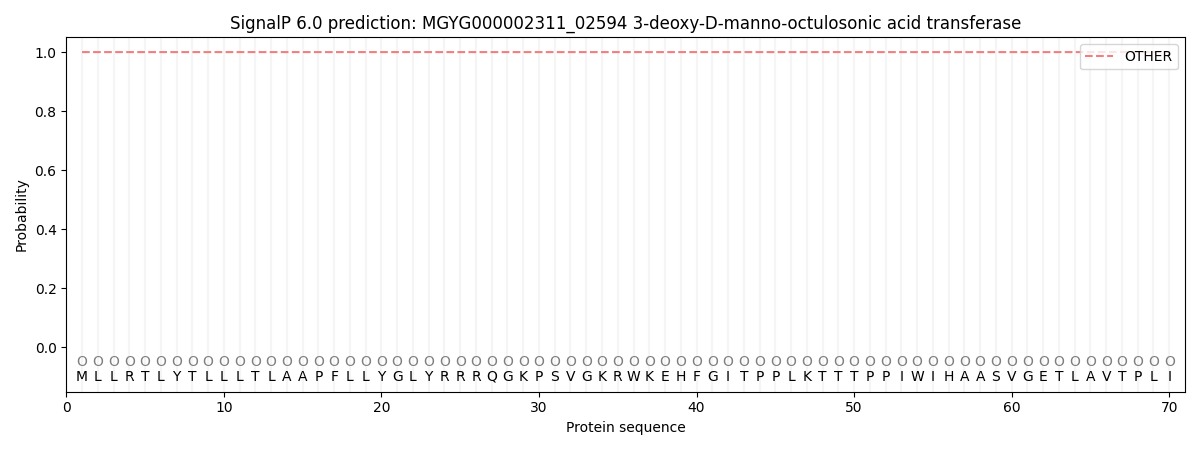You are browsing environment: HUMAN GUT
CAZyme Information: MGYG000002311_02594
You are here: Home > Sequence: MGYG000002311_02594
Basic Information |
Genomic context |
Full Sequence |
Enzyme annotations |
CAZy signature domains |
CDD domains |
CAZyme hits |
PDB hits |
Swiss-Prot hits |
SignalP and Lipop annotations |
TMHMM annotations
Basic Information help
| Species | Vibrio cholerae | |||||||||||
|---|---|---|---|---|---|---|---|---|---|---|---|---|
| Lineage | Bacteria; Proteobacteria; Gammaproteobacteria; Enterobacterales; Vibrionaceae; Vibrio; Vibrio cholerae | |||||||||||
| CAZyme ID | MGYG000002311_02594 | |||||||||||
| CAZy Family | GT30 | |||||||||||
| CAZyme Description | 3-deoxy-D-manno-octulosonic acid transferase | |||||||||||
| CAZyme Property |
|
|||||||||||
| Genome Property |
|
|||||||||||
| Gene Location | Start: 2871863; End: 2873143 Strand: - | |||||||||||
CAZyme Signature Domains help
| Family | Start | End | Evalue | family coverage |
|---|---|---|---|---|
| GT30 | 34 | 212 | 1.9e-68 | 0.9887005649717514 |
CDD Domains download full data without filtering help
| Cdd ID | Domain | E-Value | qStart | qEnd | sStart | sEnd | Domain Description |
|---|---|---|---|---|---|---|---|
| COG1519 | KdtA | 0.0 | 14 | 418 | 12 | 415 | 3-deoxy-D-manno-octulosonic-acid transferase [Cell wall/membrane/envelope biogenesis]. |
| PRK05749 | PRK05749 | 0.0 | 14 | 418 | 13 | 417 | 3-deoxy-D-manno-octulosonic-acid transferase; Reviewed |
| pfam04413 | Glycos_transf_N | 2.09e-68 | 37 | 212 | 1 | 176 | 3-Deoxy-D-manno-octulosonic-acid transferase (kdotransferase). Members of this family transfer activated sugars to a variety of substrates, including glycogen, fructose-6-phosphate and lipopolysaccharides. Members of the family transfer UDP, ADP, GDP or CMP linked sugars. The Glycos_transf_N region is flanked at the N-terminus by a signal peptide and at the C-terminus by Glycos_transf_1 (pfam00534). The eukaryotic glycogen synthases may be distant members of this bacterial family. |
| pfam00534 | Glycos_transf_1 | 1.55e-05 | 242 | 400 | 14 | 155 | Glycosyl transferases group 1. Mutations in this domain of PIGA lead to disease (Paroxysmal Nocturnal haemoglobinuria). Members of this family transfer activated sugars to a variety of substrates, including glycogen, Fructose-6-phosphate and lipopolysaccharides. Members of this family transfer UDP, ADP, GDP or CMP linked sugars. The eukaryotic glycogen synthases may be distant members of this family. |
| cd03801 | GT4_PimA-like | 0.002 | 247 | 407 | 208 | 351 | phosphatidyl-myo-inositol mannosyltransferase. This family is most closely related to the GT4 family of glycosyltransferases and named after PimA in Propionibacterium freudenreichii, which is involved in the biosynthesis of phosphatidyl-myo-inositol mannosides (PIM) which are early precursors in the biosynthesis of lipomannans (LM) and lipoarabinomannans (LAM), and catalyzes the addition of a mannosyl residue from GDP-D-mannose (GDP-Man) to the position 2 of the carrier lipid phosphatidyl-myo-inositol (PI) to generate a phosphatidyl-myo-inositol bearing an alpha-1,2-linked mannose residue (PIM1). Glycosyltransferases catalyze the transfer of sugar moieties from activated donor molecules to specific acceptor molecules, forming glycosidic bonds. The acceptor molecule can be a lipid, a protein, a heterocyclic compound, or another carbohydrate residue. This group of glycosyltransferases is most closely related to the previously defined glycosyltransferase family 1 (GT1). The members of this family may transfer UDP, ADP, GDP, or CMP linked sugars. The diverse enzymatic activities among members of this family reflect a wide range of biological functions. The protein structure available for this family has the GTB topology, one of the two protein topologies observed for nucleotide-sugar-dependent glycosyltransferases. GTB proteins have distinct N- and C- terminal domains each containing a typical Rossmann fold. The two domains have high structural homology despite minimal sequence homology. The large cleft that separates the two domains includes the catalytic center and permits a high degree of flexibility. The members of this family are found mainly in certain bacteria and archaea. |
CAZyme Hits help
| Hit ID | E-Value | Query Start | Query End | Hit Start | Hit End |
|---|---|---|---|---|---|
| AET28080.1 | 7.39e-312 | 1 | 426 | 1 | 426 |
| QJS86271.1 | 7.39e-312 | 1 | 426 | 1 | 426 |
| APF76451.1 | 7.39e-312 | 1 | 426 | 1 | 426 |
| QPC53540.1 | 7.39e-312 | 1 | 426 | 1 | 426 |
| AWB75357.1 | 7.39e-312 | 1 | 426 | 1 | 426 |
PDB Hits download full data without filtering help
| Hit ID | E-Value | Query Start | Query End | Hit Start | Hit End | Description |
|---|---|---|---|---|---|---|
| 4BFC_A | 6.38e-28 | 231 | 412 | 40 | 221 | ChainA, 3-DEOXY-D-MANNO-OCTULOSONIC-ACID TRANSFERASE [Acinetobacter baumannii] |
Swiss-Prot Hits download full data without filtering help
| Hit ID | E-Value | Query Start | Query End | Hit Start | Hit End | Description |
|---|---|---|---|---|---|---|
| P0AC77 | 1.18e-107 | 3 | 415 | 2 | 413 | 3-deoxy-D-manno-octulosonic acid transferase OS=Escherichia coli O157:H7 OX=83334 GN=waaA PE=3 SV=1 |
| P0AC75 | 1.18e-107 | 3 | 415 | 2 | 413 | 3-deoxy-D-manno-octulosonic acid transferase OS=Escherichia coli (strain K12) OX=83333 GN=waaA PE=1 SV=1 |
| P0AC76 | 1.18e-107 | 3 | 415 | 2 | 413 | 3-deoxy-D-manno-octulosonic acid transferase OS=Escherichia coli O6:H1 (strain CFT073 / ATCC 700928 / UPEC) OX=199310 GN=waaA PE=3 SV=1 |
| P44806 | 5.26e-95 | 4 | 415 | 3 | 416 | 3-deoxy-D-manno-octulosonic acid transferase OS=Haemophilus influenzae (strain ATCC 51907 / DSM 11121 / KW20 / Rd) OX=71421 GN=waaA PE=1 SV=1 |
| Q45374 | 1.79e-54 | 4 | 418 | 3 | 423 | 3-deoxy-D-manno-octulosonic acid transferase OS=Bordetella pertussis OX=520 GN=waaA PE=1 SV=1 |
SignalP and Lipop Annotations help
This protein is predicted as OTHER

| Other | SP_Sec_SPI | LIPO_Sec_SPII | TAT_Tat_SPI | TATLIP_Sec_SPII | PILIN_Sec_SPIII |
|---|---|---|---|---|---|
| 1.000040 | 0.000000 | 0.000000 | 0.000000 | 0.000000 | 0.000000 |
